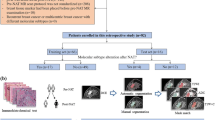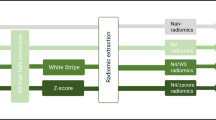Abstract
Patients with supratentorial high-grade glioma underwent surgery within a vertically open 0.5-T magnetic resonance (MR) system to evaluate the efficacy of intraoperative MR guidance in achieving gross-total resection. For 31 patients, preoperative clinical data and MR findings were consistent with the putative diagnosis of a high-grade glioma, in 23 cases in eloquent regions. Tumor resections were carried out within a 0.5-T MR SIGNA SP/i (GE Medical Systems, USA). The resection of the lesion was carried out using fully MR compatible neurosurgical equipment and was stopped at the point when the operation was considered complete by the surgeon viewing the operation field with the microscope. We repeated imaging to determine the residual tumor volume only visible with MRI. Areas of tissue that were abnormal on these images were localized in the bed of resection by using interactive MR guidance. The procedure of resection, imaging control and interactive image guidance was repeated where necessary. Almost all tissue with abnormal characteristics was resected, with the exception of tissue localized in eloquent brain areas. The diagnosis of glioblastoma was confirmed in all 31 cases. When comparing the tumor volume before resection and at the point where the neurosurgeon would otherwise have terminated surgery (“first control”), residual tumor tissue was detectable in 29/31 patients; the mean residual tumor volume was 30.7±24%. After repeated resections under interactive image guidance the mean residual tumor volume was 15.1%. At this step we found tumor remnants only in 20/31 patients. The perioperative morbidity (12.9%) was low. Twenty-seven patients underwent sufficient postoperative radiotherapy. We found a significant difference (logrankp=0.0037) in the mean survival times of the two groups with complete resection (n=10, median survival time 537 days) and incomplete resection (n=17, median survival time 237 days). The resection of primary glioblastoma multiforme under intraoperative MR guidance as demonstrated is a possibility to achieve a more complete removal of the tumor than with conventional techniques. In our small but homogeneous patient group we found an increase in the median survival time in patients with MRI for complete tumor resection, and the overall surgical morbidity was low.






Similar content being viewed by others
References
Kreth FW, Berlis A, Spiropoulu V et al (1999) The role of tumor resection in the treatment of glioblastoma multiforme in adults. Cancer 86:2117–2123
Kowalczuk A, Macdonald RL, Amidei C et al (1997) Quantitative imaging study of extent of surgical resection and prognosis of malignant astrocytomas. Neurosurgery 41:1028–1036
Puchner MJ, Herrmann HD, Berger J, Cristante L (2000) Surgery, tamoxifen, carboplatin, and radiotherapy in the treatment of newly diagnosed glioblastoma patients. J Neurooncol 49:147–155
Hulshof MC, Koot RW, Schimmel EC, Dekker F, Bosch DA, Gonzalez D (2001) Prognostic factors in glioblastoma multiforme. 10 years experience of a single institution. Strahlenther Onkol 177:283–290
Paszat L, Laperriere N, Groome P, Schulze K, Mackillop W, Holowaty E (2001) A population-based study of glioblastoma multiforme. Int J Radiat Oncol Biol Phys 51:100–107
Latif AZB, Signorini DF, Whittle IR (1998) Treatment by a specialist surgical neuro-oncologist does not provide any survival advantage for patients with a malignant glioma. Br J Neurosurg 12:29–32
Lacroix M, Abi-Said D, Fourney DR et al (2001) A multivariate analysis of 416 patients with glioblastoma multiforme: prognosis, extent of resection, and survival. J Neurosurg 95:190–198
Imperato JP, Paleologos NA, Vick NA (1990) Effects of treatment on long-term survivors with malignant astrocytomas. Ann Neurol 28:818–822
Keles GE, Anderson B, Berger MS (1999) The effect of extent of resection on time to tumor progression and survival in patients with glioblastoma multiforme of the cerebral hemisphere. Surg Neurol 52:371–379
Chandler KL, Prados MD, Malec M, Wilson CB (1993) Long-term survival in patients with glioblastoma multiforme. Neurosurgery 32:716–720
Miller PJ, Hassanein RS, Giri PGS, Kimler BF, O’Boynick P, Evans RG (1990) Univariate and multivariate statistical analysis of high-grade gliomas: the relationship of radiation dose and other prognostic factors. Int J Rad Oncol Biol Phys 19:275–280
Nazzaro JM, Neuwelt EA (1990) The role of surgery in the management of supratentorial intermediate and high-grade astrocytomas in adults. J Neurosurg 73:331–344
Wood JR, Green SB, Shapiro WR (1988) The prognostic importance of tumor size in malignant gliomas: a computed tomographic scan study by the Brain Tumor Cooperative Group. J Clin Oncol 6:338–343
Kreth FW, Warnke PC, Scheremet R, Ostertag CB (1993) Surgical resection and radiation therapy versus biopsy and radiation therapy in the treatment of glioblastoma multiforme. J Neurosurg 78:762–766
Weir B (1973) The relative significance of factors affecting postoperative survival in astrocytomas, grades 3 and 4. J Neurosurg 38:448–452
Scanlon PW, Taylor WF (1979) Radiotherapy of intracranial astrocytomas: analysis of 417 cases treated from 1960 through 1669. Neurosurgery 5:301–308
Finlay JL, Wisoff JH (1999) The impact of extent of resection in the management of malignant gliomas of childhood. Childs Nerv Syst 15:786–788
Quigley MR (1994) Early postoperative magnetic resonance imaging after resection of malignant glioma: objective evaluation of residual tumor and influence on regrowth and prognosis. Neurosurgery 34:1105
Albert FK, Forsting M, Sartor K, Adams HP, Kunze S (1994) Early postoperative magnetic resonance imaging after resection of malignant glioma: objective evaluation of residual tumor and its influence on regrowth and prognosis. Neurosurgery 34:45–60
Ammirati M, Vick N Liao YL, Ciric I, Mikhael M (1987) Effect of the extent of surgical resection on survival and quality of life in patients with supratentorial glioblastomas and anaplastic astrocytomas. Neurosurgery 21:210–206
Wirtz CR, Albert FK, Schwaserer M et al (2000) The benefit of neuronavigation for neurosurgery analyzed by its impact on glioblastoma surgery. Neurol Res 22:354–360
Knauth M, Wirtz CR, Tronnier VM, Aras N, Kunze S, Sartor K (1999) Intraoperative MR imaging increases the extent of tumor resection in patients with high-grade gliomas. AJNR Am J Neuroradiol 20:1642–1646
Trantakis C, Winkler D, Lindner D et al (2002) Clinical results in MR-guided therapy for malignant gliomas. Acta Neurochir 85:65–71
Wirtz CR, Knauth M, Staubert A et al (2000) Clinical evaluation and follow-up results for intraoperative magnetic resonance imaging in neurosurgery. Neurosurgery 46:1120–1122
Laufer M, Schaffranietz L, Rudolph C, Schneider JP, Schulz T (1999) Anesthesiologic technical problems in procedures with open MRI Results following 104 anesthesias. Anaesthesist 48:51–56
Schneider JP, Schulz T, Schmidt F et al (2001) Gross-total surgery of supratentorial low-grade gliomas under intraoperative MR guidance. AJNR Am J Neuroradiol 22:89–98
Schenck JF, Jolesz FA, Roemer PB et al (1995) Superconducting open-configuration MR imaging system for image-guided therapy. Radiology 195:805–814
Schulz T, Schneider JP, Winkel A et al (1999) MR-track pointer. A reusable device for localization during interventions. Fortschr Röntgenstr 171:244–248
Seifert V, Zimmermann M, Trantakis C et al (1999) Open MRI-guided neurosurgery. Acta Neurochir (Wien) 141:455–464
Schwartz RB, Hsu L, Wong TZ et al (1999) Intraoperative MR imaging guidance for intracranial neurosurgery: experience with the first 200 cases. Radiology 211:477–488
Schmidt F, Dietrich J, Schneider JP et al (1998) Technological and logistic problems and first clinical results of an interventional 0.5-T MRI system used by various medical specialties. Radiologe 38:173–184
Schwartz RB, Kacher DF, Pergolizzi RS, Jolesz FA (2001) Intraoperative MR systems—midfield approaches. Neuroimaging Clin N Am 11:629–644
Kraus JA, Wenghoefer M, Schmidt MC et al (2000) Long-term survival of glioblastoma multiforme: importance of histopathological reevaluation. J Neurol 247:455–460
Dietrich J, Schneider JP, Schulz T, Seifert V, Trantakis C, Kellermann S (1998) Appearance of the resection area of brain tumors in intraoperative MRI. Radiologe 38:935–942
Dietrich J, Schulz T, Schneider JP, Trantakis C, Vitzthum HE (1999) Brain tumor resections in an open 0.5-T MR. 2 years experience from the neuroradiological viewpoint. Radiologe 39:988–994
Shi WM, Wildrick DM, Sawaya R (1998) Volumetric measurement of brain tumors from MR imaging. J Neurooncol 37:87–93
Shinoda J, Sakai N, Murase S, Yano H, Matsuhisa T, Funajoshi T (2001) Selection of eligible patients with supratentorial glioblastoma multiforme for gross total resection. J Neurooncol 52:161–171
Black PM, Alexander E III, Martin C et al (1999) Craniotomy for tumor treatment in an intraoperative magnetic resonance imaging unit. Neurosurgery 45:423–433
Bohinsky RJ, Kokkino AK, Warnick RE et al (2001) Glioma resection in a shared-resource magnetic resonance operating room after optimal image-guided frameless stereotactic resection. Neurosurgery 48:731–742
Trantakis C, Tittgemeyer M, Schneider JP et al (2003) Investigation of time-dependency of intracranial brain shift and its relation to the extent of tumor removal using intra-operative MRI. Neurol Res 25:9–12
Nimsky C, Ganslandt O, Cerny S, Hastreiter P, Greiner G, Fahlbusch R (2000) Quantification of, visualization of and compensation for brain shift using intraoperative magnetic resonance imaging. Neurosurgery 47:1070–1080
Nabavi A, Black PMcL, Gering DT et al (2001) Serial intraoperative magnetic resonance imaging of brain shift. Neurosurgery 48:787–796
Martin AJ, Hall WA, Liu H et al (2001) Brain tumor resection: intraoperative monitoring with high field strength MR imaging—initial results. Radiology 215:221–228
van Velthofen V, Auer LM (1990) Practical application of intraoperative ultrasound imaging. Acta Neurochir 105:5–13
Woydt, M, Krone A, Becker G, Schmidt K, Roggendorf W, Roosen K (1996) Correlation of intra-operative ultrasound with histopathologic findings after tumor resection in supratentorial gliomas. Acta Neurochir 138:1391–1398
Hall WA, Liu H, Martin AJ, Pozza CH, Maxwell RE, Truwit CL (2000) Safety, efficacy, and functionality of high-field strength interventional magnetic resonance imaging for neurosurgery. Neurosurgery 46:632–642
Bradley WG (2000) Achieving gross total resection of brain tumors: intraoperative MR imaging can make a big difference. AJNR Am J Neuroradiol 23:348–349
Alexander E (2001) Optimizing brain tumor resection—midfield interventional MR imaging. Neuroimaging Clin N Am 11:659–672
Tummala RP, Chu RM, Liu H, Truwit CL, Hall WA (2001) Optimizing brain tumor resection—high-field interventional MR imaging. Neuroimaging Clin N Am 11:673–683
Metzger AK, Lewin JS (2001) Optimizing brain tumor resection—low-field interventional MR imaging. Neuroimaging Clin N Am 11:651–657
Schulder M, Liang D, Carmel PW (2001) Cranial surgery navigation aided by a compact intraoperative magnetic resonance imager. J Neurosurg 94:936–945
Sutherland GR, Kaibara T, Louw D, Hoult DI, Tomanek B, Saunders J (1999) A mobile high-field magnetic resonance system for neurosurgery. J Neurosurg 91:804–813
Kelly PJ (1995) CT/MRI-based computer-assisted volumetric stereotactic resection of intracranial lesions. In: Schmidek HH, Sweet WH (eds) Operative neurosurgical techniques, 3rd edn. W.B. Saunders, Philadelphia, pp 619–635
Devaux BC, O’Fallon JR, Kelly PJ (1993) Resection, biopsy and survival in malignant glial neoplasms: a retrospective study of clinical parameters, therapy and outcome. J Neurosurg 78:767–775
Knauth M, Aras N, Wirtz CR, Dorfler A, Engelhorn T, Sartor K (1999) Surgically induced intracranial contrast enhancement. AJNR Am J Neuroradiol 20:1547–1553
Spetzger U, Thron A, Gilsbach JM (1998) Immediate postoperative CT contrast enhancement following surgery of cerebral tumoral lesions. J Comput Assist Tomogr 22:120–125
Cairncross JG, Pexman JHW, Rathbone MP, Delmaestro RF (1985) Postoperative contrast enhancement in patients with brain tumor. Ann Neurol 17:570–572
Jeffries BF, Kishore PRS, Singh KS, Ghatak NR, Krempa J (1981) Contrast enhancement in the postoperative brain. Radiology 139:409–413
Elster AD, Jackels SC, Allen NS, Marrache RC (1989) Europium-DTPA: a gadolinium analogue traceable by fluorescence microscopy. AJNR Am J Neuroradiol 10:1137–1144
Rubino GJ, Villablanca JP, Lycette C, Farahani K, Alger J (2000) Spread of contrast enhancement observed in high grade gliomas in a non-operative setting. Proc Int Soc Mag Reson Med 8:64
Schneider JP, Richter A, Lodemann KP et al (2002) Spread of contrast enhancement in supratentorial high grade gliomas—comparison of Gadobenate-Dimeglumine and Gadolinium-DTPA at 0.5 T. Eur Radiol 12:F30
Varallyay P, Nesbit G, Muldoon LL et al (2002) Comparison of two superparamagnetic viral-sized iron oxide particles ferumoxides and ferumoxtran-10 with a gadolinium chelate in imaging intracranial tumors. AJNR Am J Neuroradiol 23:510–519
Moche M, Busse H, Dannenberg C et al (2001) Image fusion of MRI and fMRI with intraoperative MRI data: methods and clinical relevance for neurosurgical interventions. Radiologe 41:993–1000
Stummer W, Stocker S, Wagner S et al (1998) Intraoperative detection of malignant gliomas by 5-aminolevulinic acid-induced porphyrin fluorescence. Neurosurgery 42:518–526
Author information
Authors and Affiliations
Corresponding author
Rights and permissions
About this article
Cite this article
Schneider, J.P., Trantakis, C., Rubach, M. et al. Intraoperative MRI to guide the resection of primary supratentorial glioblastoma multiforme—a quantitative radiological analysis. Neuroradiology 47, 489–500 (2005). https://doi.org/10.1007/s00234-005-1397-1
Received:
Accepted:
Published:
Issue Date:
DOI: https://doi.org/10.1007/s00234-005-1397-1




